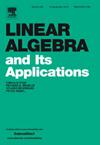The spectral reconstruction problem revisited
IF 1.1
3区 数学
Q1 MATHEMATICS
引用次数: 0
Abstract
This paper focuses on the following spectral reconstruction problem: Can a graph be uniquely determined (up to isomorphism) by the collection of its spectrum and the spectra of its vertex-deleted graphs? We say two graphs are hyper-cospectral if they share identical spectrum and identical spectra for their vertex-deleted subgraphs. A graph G is spectrally reconstructible (SRC for short) if any graph H that is hyper-cospectral with G is also isomorphic to G. Tutte [13] showed that graphs with irreducible characteristic polynomials are SRC. We aim to extend this result to a larger family of graphs known as controllable graphs. Since not all controllable graphs are SRC, we address the problem: Which controllable graphs are SRC? We provide a proof for a family of controllable bipartite graphs whose characteristic polynomials have exactly two irreducible factors. Moreover, we demonstrate that for a non-controllable graph G with a characteristic polynomial having exactly two irreducible factors, if a hyper-cospectral graph exists, then their complements are also hyper-cospectral. In addition, we also present an algorithm for determining the spectral reconstructibility of graphs whose characteristic polynomials split into exactly two irreducible factors, as well as for finding their hyper-cospectral mates when they exist. Some examples are also provided to illustrate our results.
光谱重建问题再次被讨论
本文主要研究如下的谱重建问题:图的谱和去顶点图的谱的集合能否唯一确定一个图(直到同构)?我们说两个图是超共谱图,如果它们具有相同的光谱,并且它们的删除顶点的子图具有相同的光谱。如果任何与G超共谱的图H与G同构,则图G是谱可重构的(SRC)。Tutte[13]证明了具有不可约特征多项式的图是谱可重构的。我们的目标是将这个结果扩展到更大的图族,即可控图。由于不是所有的可控图都是SRC,我们解决了这个问题:哪些可控图是SRC?给出了一类特征多项式恰好有两个不可约因子的可控二部图的证明。此外,我们还证明了对于具有两个不可约因子的特征多项式的不可控制图G,如果存在超协谱图,则它们的补也是超协谱图。此外,我们还提出了一种算法,用于确定特征多项式分裂为两个不可约因子的图的谱可重构性,以及当它们存在时寻找它们的超共谱伴侣。文中还提供了一些例子来说明我们的结果。
本文章由计算机程序翻译,如有差异,请以英文原文为准。
求助全文
约1分钟内获得全文
求助全文
来源期刊
CiteScore
2.20
自引率
9.10%
发文量
333
审稿时长
13.8 months
期刊介绍:
Linear Algebra and its Applications publishes articles that contribute new information or new insights to matrix theory and finite dimensional linear algebra in their algebraic, arithmetic, combinatorial, geometric, or numerical aspects. It also publishes articles that give significant applications of matrix theory or linear algebra to other branches of mathematics and to other sciences. Articles that provide new information or perspectives on the historical development of matrix theory and linear algebra are also welcome. Expository articles which can serve as an introduction to a subject for workers in related areas and which bring one to the frontiers of research are encouraged. Reviews of books are published occasionally as are conference reports that provide an historical record of major meetings on matrix theory and linear algebra.

 求助内容:
求助内容: 应助结果提醒方式:
应助结果提醒方式:


